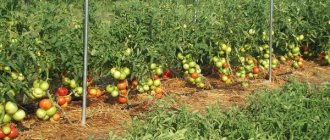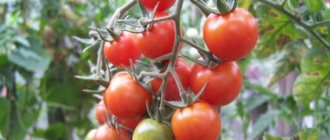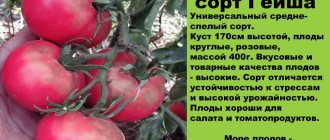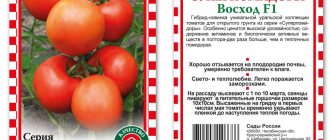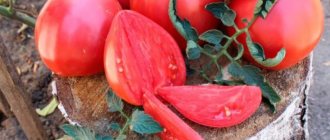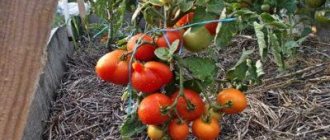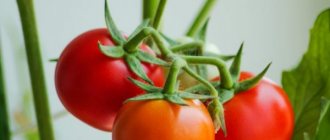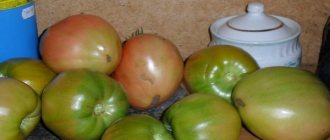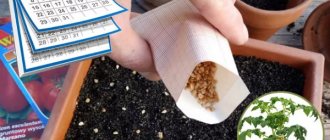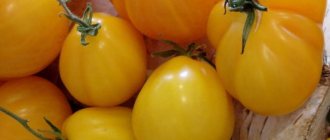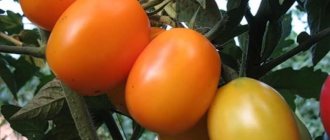| Ripening period: | early ripening, 85-90 days |
| Shape, weight of fruits: | rounded-flattened, 100-150 gr. |
| Bush type: | determinant (short), 50-60 cm |
| Growing regions: | all around Russia |
| Productivity: | 6 kg per bush |
Many summer residents, gardeners, and often farmers, when choosing varieties or hybrids for planting, first of all look at who produces them. When the “Bejo” logo is on the packaging, this means that the planting material will be of high quality. The Polfast tomato was developed by the breeders of this company; it is distinguished by high commercial characteristics of the fruit, disease resistance and good taste.
Description and characteristics of the variety
Polfast was bred by breeders of the world famous Dutch seed breeding company.
The hybrid was registered in the State Register of Varieties of Russia in 2005. Polfast is distinguished by its early ripening period: the period from sowing tomato seeds to harvest is 85-90 days. From planting tomato seedlings to harvesting ripe fruits, 55-56 days pass. In the southern regions, the hybrid ripens in June, and in the middle zone - in July.
The plant is strong, powerful, with good growth vigor, medium foliage. The bush's habit is compact, which allows gardeners to plant more tomatoes in a smaller area. Polfast grows on average to 50-60 cm, but when cultivated in a greenhouse it reaches 1 m.
Tomato fruits are beautiful, round, slightly flattened (see photo). Tomatoes are elastic, smooth, with a strong, elastic skin that is resistant to mechanical damage.
The tomatoes are intensely colored - bright red, shiny, there is no green spot near the stalk. Moreover, the pulp is also well colored, it is rich red, appetizing, fleshy, with a high content of dry substances. According to the description, tomato Polfast F1 differs from other early-ripening hybrids in its high taste.
In practice, the plant has excellent resistance to various negative weather factors; in particular, the fruits set well and ripen even when the temperature drops.
Tomatoes Polfast F1 are characterized by good, stable yield. Moreover, the hybrid shows high productivity both in open ground (in beds or in the field) and in protected ground (film tunnels, greenhouses, greenhouses).
The variety is characterized by high shelf life, transportability, and does not lose commercial qualities even during long-term transportation. Due to the combination of these qualities, the hybrid is of great commercial interest.
Tomato Polfast is suitable for fresh consumption, as well as for all types of processing (home, industrial). Tomatoes are used to make sauces, juices, ketchups, tomato paste, used for canning (whole fruit), pickled and fermented. The fruits of Polfast are also used for preparing first and second courses.
Disease Prevention
“Polfast F1” is a variety that is highly resistant to various tomato diseases. This is due to the fact that the seeds are pre-treated and fully prepared for sowing, so they do not need washing or other procedures, since this can wash away the useful, protective layer.
Seedlings with a root system treated with Fitosporin can also be planted directly into the ground. This natural product, made from living microorganisms, protects the roots by covering them with a thin but dense film. Another remedy is “Immunocytophyte”. Its solution is obtained by diluting one tablet in one hundred grams of water; seedlings can be kept in it for 3 to 12 hours. In fact, both compositions stimulate the growth of tomatoes and at the same time increase resistance to diseases.
Varietal hybrids, such as Polfast, can also be treated with a solution of potassium permanganate for preventive purposes. The seeds in the bag are placed in a thermos with hot water (up to +50 degrees), kept there for about two hours, and then placed in highly diluted potassium permanganate for 30 minutes. This avoids infection with viruses and fungal infections.
To prevent illness, it is also important to take the following measures:
- promptly remove weeds from the beds;
- regularly loosen the soil for maximum drainage;
- on hot days, do not forget to thoroughly water the root system.
Late blight is an extremely common disease among tomatoes caused by lower fungi. And although, due to early ripening, the Polfast F1 variety almost never encounters this disease, cases of damage are still sometimes present. Therefore, when the first unpleasant symptoms appear, it is worth recommending the use of products such as Quadris, Trichodermin or Previkur, Thanos, Ridomil and Kuproxat. They will help in the later stages of infection. Other preparations containing copper are also suitable for this purpose.
Tomatoes are susceptible to various pests, such as spider mites, thrips, whiteflies, rust bugs, mole crickets and others. In the fight against them, insecticidal compounds should be used - “Aktara”, “Chlorophos”, “Agrovertin”. Aphids are simply washed off the leaves with a soapy water solution, slugs are eliminated with diluted ammonia. In order for Polfast F1 tomatoes to grow well and bear selected fruits, the soil should not be highly acidic, that is, contain a high level of hydrogen ions.
Tomato growth may slow down or even stop due to sudden temperature changes, so this factor should be taken into account. Positive reviews about the hybrid variety confirm that the crop invariably pleases with a stable amount of product, and diseases accompanying plant growth are most likely associated with violations of basic agrotechnical rules and occur extremely rarely.
Farmers emphasize that due to the dense structure of the tomato skin and pulp, it is not afraid of even excessive watering. Apparently, the Polfast F1 hybrid is the optimal crop for both experienced and novice farmers. By following the rules of soil preparation and planting, the harvests will be large and of high quality.
To learn how to distinguish a real Polfast F1 variety from a fake, see below.
Planting and care
Hybrid Polfast F1 was bred for cultivation not only in protected but also in open ground. The planting density is 7-8 pcs. per 1 sq. m, but they sit tighter. Then the distance between plants and row spacing is 30 cm. But with such planting of tomatoes, attention is paid to maintaining a high agricultural background.
In the south, seeds for seedlings begin to be sown from the end of February or early March, in other regions from the end of March - beginning of April. Seedlings are planted in a greenhouse in April-May, and in open ground in May-June. Before this, the soil needs to be fertilized and then sprayed with insecticide against pests. Watering is carried out as the soil dries out.
Growing seedlings
An unpretentious crop is planted in fertilized soil in early spring. Immediately after winter, the soil for planting is loosened and saturated with useful substances. Seedlings intended for greenhouse conditions show high resistance even in dry soil and at high temperatures.
Planting of the future bush occurs in the warm season, in pre-fertilized soil. The bush planting scheme is quite simple:
- the distance from one tomato to another is half a meter (if the crop is planted in a greenhouse, the distance is reduced to 20-30 cm);
- seeding density is 8 plants per 1 square meter;
- The root system of the future dense bush is lowered into a small hole (20-30 cm) and watered abundantly with clean water.
For a healthy bush and a good harvest in the fall, the seedlings should be planted correctly. Plant 2-3 sprigs of seedlings in one hole at once. To protect the rhizome from pests during planting, protective films are used.
The hybrid tomato has a quick survival rate, so immediately after planting the bush grows moderately. After upward growth is completed, the crop grows around the root system.
Care and fertilization
Caring for plants will not cause you any trouble
The f1 variety does not require special care. Abundant watering and periodic fertilization help strengthen the stems, root system and fruits from various diseases.
Roots treated with Fitosporin are planted in open, moist soil. A product based on active living bacteria allows you to cover the roots with an invisible protective film. The fruit hybrid is watered 5-6 times a month, and during the rainy season, in addition to watering, the soil is constantly fertilized with nitrogen-containing substances.
The safest for the crop is wood ash, used no more than 2 times a month. High temperatures require a change in the irrigation system: the plant and its roots are irrigated every 2-3 days. Stop fertilizing the plant 2 weeks before harvest. During this period, even diseased crops are treated using absolutely safe natural remedies.
Diseases of the variety
The Dutch hybrid tolerates various diseases well and resists seasonal diseases. Juicy tomatoes rarely get sick or start to rot. Even abundant watering is not a threat to a dense tomato. The hybrid is not susceptible to verticillium and fusarium.
An early ripening tomato variety does not fall under the late blight season. Tomatoes ripen quickly and rarely crack, excluding infectious diseases of the entire bush.
Description and characteristics, pros and cons of the Marble pear variety, pollinators and cultivation
Disease resistance
Polfast F1 has high immunity to common tomato diseases, especially verticillium and fusarium. It is resistant to ticks and other pests.
Even with good resistance, Polfast tomatoes can occasionally be affected by diseases and harmful insects. And this significantly affects the ripening period, yield indicators, the size of the fruit and the vitality of the plant as a whole. Therefore, 2-3 preventive treatments of the hybrid are carried out per season with plant protection products.
It is advisable to use high-quality insecticides and fungicides in branded packaging. For adherents of organic vegetables, spraying bushes can only be done with biological products; the main thing is to follow the dosage and not use those that have expired.
Advantages and disadvantages
Both an experienced farmer and a simple summer resident, before deciding whether to plant Polfast F1 on their plot or not, need to study the full characteristics and description of the variety, highlighting its positive and negative aspects.
Advantages of a hybrid:
- stable tomato yield indicators;
- compact habit, allowing you to plant more plants per square meter;
- high commercial characteristics, beautiful fruit color, tomatoes are suitable for both retail and wholesale fresh vegetable markets;
- good taste of fruits, as well as balance of sugar and acid;
- versatility of fruit use;
- resistance to many diseases and pests characteristic of tomatoes;
- resistance to temperature changes and other negative natural conditions;
- good growth energy, erect, strong bush;
- tomato is easy to cultivate without the use of supports or trellises;
- Suitable for growing in both open and closed ground conditions.
- the seeds are treated with Thiram, so there is no need for pre-sowing treatment.
Among the disadvantages, gardeners note poor fruit set in hot weather.
Features of cultivation
Early varieties, like Polfast f1, must be grown through seedlings. Seeds should be planted after March 15th. There is no need for soaking or additional processing of seed material, because hybrid species are fully processed before going on sale.
For a successful start to the season, you need to plant Polfast seeds in a high-quality substrate. Nutrient soil should be made from humus and garden soil. It is possible to add a small portion of clean river sand or wood ash. The depth of the seeds in the soil should not exceed 2 centimeters, otherwise germination will take too long or become impossible. The soil is first sprayed with warm water, and after sowing it is covered with a thick film.
The temperature required for rapid seed germination should be between 24 and 25 degrees. When the first shoots appear, the containers are placed in a bright place, and the temperature in the room should drop slightly.
If there is a lack of sunlight, you should think about supplementary lighting. Fluorescent lamps are well suited for this purpose.
Once the Polfast seedlings reach the growth phase, when two true leaves appear, it is worth carrying out the picking process. Afterwards, you should definitely feed the young plants with complex fertilizer. Hybrids are distinguished by early fruiting, which must be taken into account when transplanting seedlings into the ground. After 52 - 54 days, the first ripened fruits of Polfast will appear.
See also
Description of the tomato variety Success, characteristics and recommendations for growingRead
Similar hybrids
The following low-growing tomatoes are similar to the Polfast F1 tomato variety:
- Tomato Polbig F. This is a determinate hybrid of early ripening (72-82 days). The tomato is distinguished by beautiful, flat-rounded fruits. They are rich, red in color, with an average weight of 200 g. The bush is powerful and low. Polbig has good keeping quality and transportability, as well as high tasting characteristics of the fruit.
- Tomato variety Sanka. Early ripening, 90-100 days. The cultivar is low-growing, with a height of 50-60 cm. The fruits are beautiful, round, deep red, with fleshy and dense pulp. It is characterized by excellent taste, proven resistance to adverse factors, and good yield. Suitable for open (beds, fields) and protected ground.
- Turbojet F1. This is an early, determinate hybrid with excellent fruit taste. The skin is rich red, the flesh is dense but juicy. The average weight of tomatoes is 80 grams.
